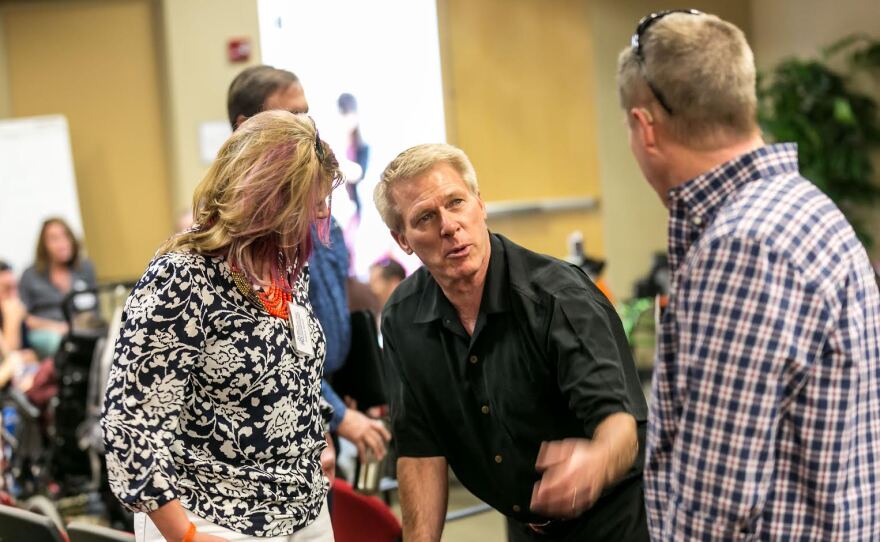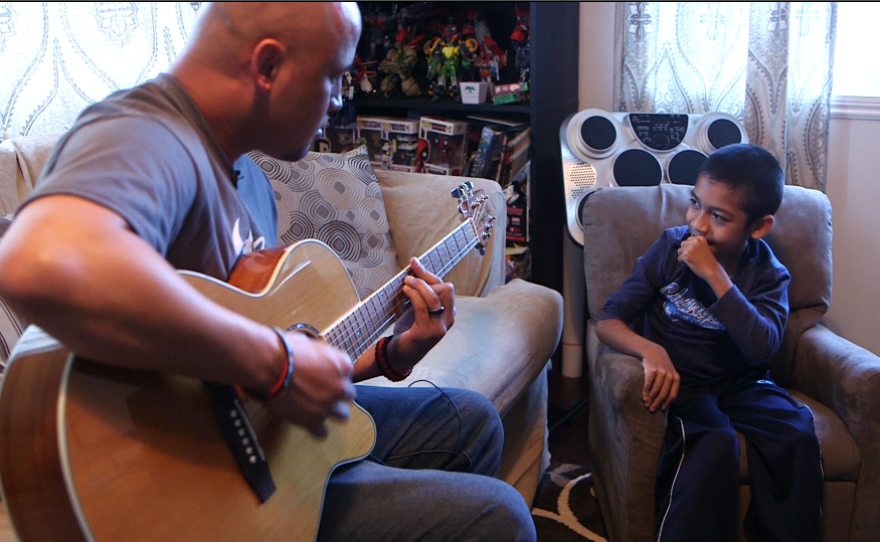Raising a child with a developmental disorder is hard. It is even harder when that disorder is so rare, most doctors have never heard of it.
Two San Diego families have turned to a local scientist in hopes of tracking down a diagnosis for their children. Their experience reveals how far research on rare diseases has come in recent years — and how many challenges still remain.
On a typical afternoon, Diana Papworth can be found playing backyard bocce ball with her two kids, Shaun and Lauren. Well, they're not exactly kids. Meeting them is like interacting with a pair of playful and outgoing 6 year olds. But Shaun and Lauren are both in their 30s.
For years, this Santee mother couldn't get any doctor to tell her why they were missing their milestones.
“It was scary," Papworth said. "We didn’t know what to expect. We didn’t know if things were going to get worse.”
When they were younger, Shaun and Lauren had regular seizures. They also have some cerebral palsy and neuropathy. After decades of dead-ends, Papworth eventually accepted that she might never get a diagnosis.
“You have to go on with life," she said. "You have to do the best with what you have. So we just kind of gave up.”
But then, after Shaun's seizures started to flare up again, Papworth was referred to Dr. Jennifer Friedman, a neurologist at Rady Children’s Hospital.
Friedman had a hunch about what was going on. She sent Shaun and Lauren in for a skin biopsy.
“I remember going in there thinking they’re not going to find anything," Papworth said. "We’ve been dealing with this for 33 years, and no one can tell us. It’s never even been close. I honestly felt like they weren’t going to find it.”
But they did find something. Friedman had reached out to Hudson Freeze, a scientist at the Sanford Burnham Prebys Medical Discovery Institute in La Jolla. Freeze does research on a rare disease known as CDG.
“That is short for congenital disorders of glycosylation," Freeze said.
Glycosylation is a cellular process that involves attaching sugar chains to proteins. It's vital to normal cell function throughout the body — when it goes awry, multiple organs can be affected.
Many genes are involved in proper glycosylation. And when two parents happen to carry a mutation on the exact same gene, they end up with a one-in-four chance of passing both mutated copies on to their kid.
“When that happens, you get a myriad of different kind of genetic abnormalities and physiological dysfunctions,” Freeze said.

CDG is a spectrum. Different subtypes of the disorder lead to different symptoms. Some patients, like Shaun and Lauren, live into adulthood with minimal physical problems. Others have more severe impairments and much shorter lifespans.
Freeze and his colleagues help families narrow in on a CDG diagnosis by looking at skin cells from suspected patients. They don't offer a clinical diagnosis, but they can point families in the right direction. When they put Shaun and Lauren’s cells under the microscope, they saw the hallmarks of CDG.
“We got on the phone to mom minutes, literally minutes, after we had made the discovery,” Freeze said.
CDG is already rare, with only a few thousand cases identified worldwide. Shaun and Lauren have a particularly rare subtype.
“They have mutations in a gene called ALG3," Freeze said. "They are the 15th and 16th patients that we know of in the world.”
Diana Papworth knows there’s no cure for a disease this uncommon. That's true for most CDG patients. Freeze and other scientists have shown that patients with the subtype CDG1b can alleviate symptoms by ingesting a sugar called mannose, but other CDG subtypes don't come with proven therapies.
Still, Papworth said having a diagnosis makes her feel less isolated, because now she knows that other families have been going through the same thing.
"I'm not really sure where we go from here, but I'm excited," she said.
Because CDG is so rare, research has been limited and funding has been scarce. That means not every family gets a clear answer right away.
Donnie Omler’s 7-year-old son Damian can laugh while joining the family for a game of Mario Kart. But he can't communicate verbally. He uses a wheelchair and has other symptoms pointing to CDG. His Linda Vista parents are now accustomed to fielding the question, "What's wrong with your son?"
“In the beginning, it really annoyed us because we didn’t know how to answer it," Omler said. "Because we didn’t know the answers."
Doctors have also been stumped. But Donnie has been determined to track down a diagnosis. He actually hand-delivered Damian’s skin cells to Hudson Freeze’s lab for analysis.

Parents say hospitals and insurance companies can be hesitant to help them pursue a CDG diagnosis. Many have never dealt with a CDG patient, and doctors don't want to open themselves to liability.
Omler has also struggled to get certain government services and health coverage for Damian, because the necessary paperwork always asks for a diagnosis. For years, he didn't have a precise diagnosis to write down.
Freeze and his colleagues have been able to narrow in on a gene they believe is causing Damian's condition, but it's a gene that has never been linked with CDG before.
“They weren’t able to find another case like Damian’s," Omler said.
If Damian does in fact have CDG, he would be the only confirmed case with this subtype in the world — the first patient known to science.
“So they don’t have a prognosis on how long the life expectancy is," Omler said. "They don’t know if it’s going to get worse, they don’t know if it’s going to get any better. So there’s a lot they don’t know. And we understand that."
Freeze said this isn't just research to him. His sister has an undiagnosed disorder. So he understands what these families are going through.
For the past six years, he has organized an annual symposium in San Diego where families coping with CDG can meet each other and talk with knowledgable doctors and scientists.
Freeze said one of the hardest parts is seeing patients die over the years.
“Yeah it’s really personal," he said. "We celebrate when we can give good news. And we feel for it when the patients die.”
Half of Freeze’s funding comes from families donating to help his lab continue working on CDG. He hopes his research can lead to answers for families who’ve had nothing but questions for so many years.






